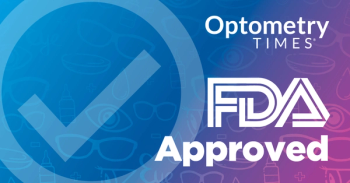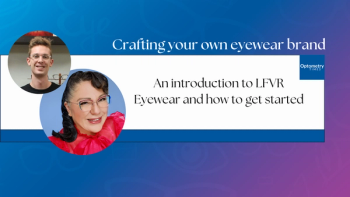
5 steps for better contact lens wear
Keeping contact lenses clean is the key to healthier and more comfortable lens wear. Incorporating these 5 steps into your practice may help you to ensure happier patients with more comfortable lens wear.
Our contact lens (CL) patients are constantly searching for a cleaner, more comfortable lens. Consider these 5 steps to help you recommend a cleaner, healthier lens wearing experience.
1. Rubbing lenses
Although many patients have adopted a no-rub regimen for lenses that require lens care, there is still significant value to this practice. Part of the reason for this may be because of previous package labeling, and part may be secondary to complacent instructions given to patients by practitioners when recommending lens care solutions. Within the past 3 years there have been three new CL solutions on the market; none of them have no-rub labeling on their bottles. So now it is incumbent upon the eyecare practitioner to educate patients on this vital habit to optimize lens-wearing success.
It has been well established that patients who rubbed their lenses reduced deposits on the surfaces of CLs compared with patients who simply rinsed and stored their lenses.1 In the new era of silicone hydrogel (SiHy) lenses, it has been well established that SiHy lenses have very different deposition characteristic profiles than their hydrogel predecessors.2 Hydrogels tend to deposit more proteins than SiHys do, and SiHys tend to deposit more lipids than hydrogels do.3 Certain lens care systems are better designed to effectively remove lipids from the surfaces of lenses.4 As such, it is incumbent upon us as eyecare practitioners to strongly recommend the solutions we want our patients to use and also to reinforce proper use of the solutions, including correctly rubbing the lens.
2. Identifying allergy sufferers
Patients who suffer from allergies tend to produce excessive mucous and discharge while their allergies are active.5 Additionally, allergy patients are more likely to be symptomatic of CL discomfort. This is a concern particularly because the prevalence of allergies tends to be between 20%-40% of the population.6 Additionally, 70% of those persons who have systemic allergies will also have ocular symptoms.7
Although some of our patients will come in when symptomatic or let us know of allergy symptoms at other times of the year, many of our patients won’t tell us of ocular symptoms, even when questioned, leading to underdiagnosing the condition.8 Patients, at times, will minimize certain symptoms during CL check-ups because those patients may think that our recommendation would be to discontinue CL wear. These patients will, unfortunately, attempt to self-treat with over-the-counter options or temporally limiting lens wear.
Not identifying these patients during yearly visits is a concern. That’s why we have our patients bring in any CL care products-such as the case, solution, and any drops they may use-to CL appointments. This will give us an accurate view of what our patients are actually using, including using drops for discomfort during allergy season.
Fortunately, we have effective options to help patients with allergies during this season, but it ultimately depends on us identifying these patients. Prescribing an effective mast cell stabilizer/anti-histamine combination will help allergy patients by reducing symptoms and the amount of discharge produced by the eyes. Additionally, recommending a peroxide care system works well for these patients by providing maximum disinfection efficacy along with a high level of cleaning efficacy.
3. Be vigilant about replacement compliance
It may sound surprising, but daily disposable contact lenses (DDCLs) should be replaced daily, 2-week lenses should be replaced every 2 weeks, and monthly lenses on a monthly basis. The compliance rate of each of the lens modalities varies significantly. DDCLs win the compliance battle because 88% of patients replace them as scheduled. Two-week lenses have a 48% compliance rate, while monthly lens wearers replace lenses with 72% compliance. In fact, 2-week lens wearers wear their lenses on average for 27 days (2.6x the manufacturers’ recommended replacement frequency (MRRF) and 1-month wearers wear theirs for 47 days on average (1.5x the MRRF).9,10 Manufacturers set these replacement schedules based on their impressions of what will provide the patient with the optimal lens-wearing experience. So, it is essential for both doctors and patients to follow this replacement schedule.
Some patients may need to replace lenses on a more frequent basis, but exceeding the recommended replacement schedule may put the patient at risk for suboptimal lens experiences, including deposit buildup. Although it seems obvious that replacing lenses is better for patients, researchers discovered that patients achieved better end-of-day comfort, better vision, better end-of-day comfort at the close of the lens wearing cycle (2-week or 1-month), and better vision at the close of the lens wearing cycle (2-week or 1-month).11
By having patients follow the MRRF with a reminder that it will enhance the lens-wearing experience, we can help patients gain better comfort and better vision.
4. Understand CL solutions can improve surface qualities
CL solutions are a vital part of patients’ CL wearing experience. When a patient doesn’t replace his or her lenses on a daily basis, it is crucial that he or she use a CL solution that is compatible with the lens. Many of our patients are wearing SiHy lenses, and as such, the solution that patients use should reflect the technology.
Many of the soft lenses that we prescribe have a hydrophobic (water-repelling) backbone. However, when patients initially place them on their eyes, the lenses have hydrophilic (water-loving) sites on the lens surface. As the tear surface becomes unstable throughout the day and begins to break up, the hydrophilic groups will migrate into the lens that produces a hydrophobic surface.13 One study, looking at the capabilities of a newer CL solution, found that the solution’s unique wetting agent would embed itself into the hydrophobic areas, which recreates the hydrophilic nature of the lens.
Older technology lens solutions, such as private label and generic, do not have the unique wetting capabilities designed specifically for SiHy lenses because they were invented prior to SiHy lenses hitting the market.
Ensure that each patient is using the lens solution that you recommended during the annual exam. Be sure to explain to your patients the rationale of why you are prescribing it. By making certain that patients are utilizing updated solutions, you can help to keep the surface of his or her lens clear so that deposits don’t have a chance to become embedded on the lens surface.
5. Consider daily disposables for patients who continue to have problems
DDCLs provide us with a viable option to help reduce deposition on the surface of lenses. With the lens being replaced every day, the previous day’s wear is never a factor.
There are a number of options with DDCLs. A variety of prescriptions and parameters are available in hydrogel materials. Vistakon and Alcon currently have the only SiHy daily disposable lenses on the market.
Consider these five tips to help maximize your success with minimizing lens surface deposits.ODT
References
- Cho P, Cheng SY, Chan WY, Yip WK. Soft contact lens cleaning: rub or no-rub? Ophthalmic Physiol Opt. 2009 Jan;29(1):49-57.
- Nichols JJ. Deposition on silicone hydrogel lenses. Eye Contact Lens. 2013 Jan;39(1):20-23.
- Cheung SW, Cho P, Chan B, Choy C, Ng V. A comparative study of biweekly disposable contact lenses: silicone hydrogel versus hydrogel. Clin Exp Optom. 2007 Mar;90(2):124-131.
- M. Senchyna, P. Stauffer, J. Davis, H.A. Ketelson, D. A. Meadows. Characterization of a Multi-Purpose Lens Solution Designed for Silicone Hydrogel Materials. Poster presented at the Association for Research in Vision and Ophthalmology, May 2-7, 2010, Fort Lauderdale, FL..
- Lemp MA. Contact lenses and associated anterior segment disorders: dry eye, blepharitis, and allergy. Ophthalmol Clin North Am. 2003 Sep;16(3):463-469.
- Saban DR, Calder V, Kuo CH, Reyes NJ, Dartt DA, Ono SJ, Niederkorn JY. New Twists to an Old Story: Novel Concepts in the Pathogenesis of Allergic Eye Disease. Curr Eye Res. 2013 Mar;38(3):317-30.
- Katelaris CH, Bielory L. Evidence-based study design in ocular allergy trials. Curr Opin Allergy Clin Immunol. 2008;8(5):484-8.
- Abelson M. Allergic Diseases of the Eye. Philadelphia, PA: W.B. Saunders Co; 2000.
- Dumbleton K, Woods C, Jones L, et al. Patient and practitioner compliance with silicone hydrogel and daily disposable lens replacement in the United States. Eye & Contact Lens. 2009; 35(4): 164-171.
- Dumbleton K, Woods C, Jones L, Fonn D. The relationship between compliance with lens replacement and contact lens-related problems in silicone hydrogel wearers. Cont Lens Anterior Eye. 2011; 34(5): 216-222.
- Dumbleton K, Woods C, Jones L, et al. Comfort and Vision with Silicone Hydrogel Lenses: Effect of Compliance. Optom Vis Sci. 2010;87:(6):421-425.
- Huo Y, Perry SS, Rygalov A, Wang A, Ketelson HA, Meadows DL. Chemical and frictional analysis of silicone hydrogel contact lens surfaces. Poster presented at the Association for Research in Vision and Ophthalmology, May 2-7, 2010, Fort Lauderdale, FL.
- Epstein A, Stone R. Surface and polymer chemistry: the quest for comfort. Rev Cornea Contact Lens. 2010;247(1):15-19.
- Senchyna M, Stauffer P, Davis J, et al. Characterization of a multi-purpose lens solution designed for silicone hydrogel materials. Poster presented at the Association for Research in Vision and Ophthalmology, May 2-7, 2010, Fort Lauderdale, FL.
- Sawyer WG, Dunn AC, Uruena JM, Ketelson HA. Robust Contact Lens Lubricity Using Surface Gels. Poster presented at the Association for Research in Vision and Ophthalmology, May 2-7, 2010, Fort Lauderdale, FL.
5 steps for cleaner, comfortable lens wear
1. Rubbing lenses
2. Identifying allergy sufferers
3. Be vigilant about replacement compliance
4. Understand CL solutions can improve surface qualities
5. Consider daily disposables for patients who continue to have problems
Take-home Message
Keeping contact lenses clean is the key to healthier and more comfortable lens wear. Incorporating these 5 steps into your practice may help you to ensure happier patients with more comfortable lens wear.
Author Info
Dr. Kading
Dr. Kading (left) owns a three-doctor, two-location practice in the Seattle area. Dr. Brujic (below, left) is a partner in a five-doctor, four-location practice in northwest Ohio. Together, they own Optometric Insights. Either one or both have received honoraria for consulting, performing research, speaking or writing from: Alcon Laboratories, Allergan, Bausch + Lomb, Contamac, CooperVision, Essilor, Nicox, Paragon, SynergEyes, Transitions, Valeant Pharmaceuticals, Vistakon, and Valley Contax.
Dr. Brujic
Newsletter
Want more insights like this? Subscribe to Optometry Times and get clinical pearls and practice tips delivered straight to your inbox.
















































.png)


